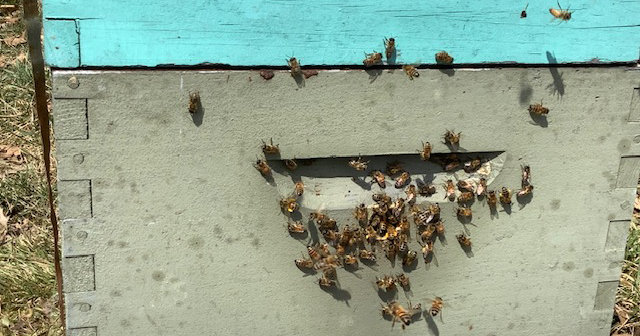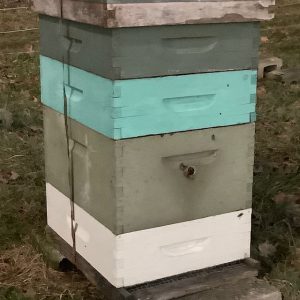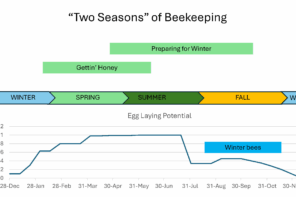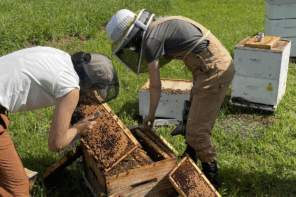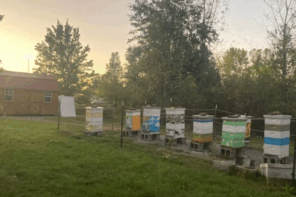Click Here if you listened. We’d love to know what you think. There is even a spot for feedback!
Read along below!
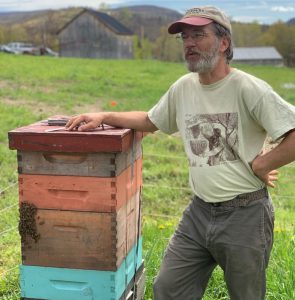
Honey Bees on the Dark Side
Observations and thoughts on honey bee
behavior during a solar eclipse
By: Ross Conrad
On April 8, 2024, northern New England won the metrological lottery. With clear skies and warm temperatures in the forecast, many considered it the best place in the U.S. to view the total eclipse of the sun. The path of totality just happened to encompass my home town of Middlbury, Vermont where some of my beeyards are located.
April 8, 2024 also broke my personal record set the previous year on April 10, 2023 for the earliest I’d ever gotten out and started unpacking, reversing and inspecting my bees following Winter. Before last year, I had never had the chance to start reversing my colonies until well into the second half of April. The bees and plants go by the weather rather than the calendar, so I follow their lead. This year it would allow me to get some work done and still catch what is most likely to be my only chance to see a total eclipse of the sun. It would also allow me to observe how my bees respond to this rare event.
Solar navigation
Honey bees are known for their ability to navigate in part by observing the sun. Once honey bees arrive near their target, they are able to use landmarks, their eye sight and their acute sense of smell to navigate to the exact location of what they’re looking for. It is their reliance on the sun for navigation that is the basis of how we interpret the “waggle dance” that bees use to inform hivemates of the direction and distance to a specific destination. The angle to the sun that the forager experienced in flight, tends to match the angle used during the waggle dance inside the hive. This angle, relative to the direction of gravity, is used as a proxy to represent the location of the sun during the dance.
They also use the polarization pattern of light in the sky to orient themselves and find their way to the general vicinity of forage blossoms, water, tree resins used to manufacture propolis, or during the act of swarming. The light that our sun emits is generally unpolarized. When sunlight is scattered by air or water molecules in the atmosphere, the scattered light changes in characteristic and becomes partly polarized. To some extent all scattered light is polarized. However, light becomes highly polarized at a scattering angle of 90° from the light source. American physicist and inventor, August Herman Pfund, used this characteristic of sunlight to invent the Pfund Sky Compass that was used in the 1950s to navigate near the poles of the earth when neither the sun nor the stars were visible.
The sun’s navigational importance for the honey bee is further reflected by reports of bees foraging at the equator. When the sun is directly overhead, bees have been observed to stop dancing and foraging flights cease. Foragers dances reportedly become disoriented whenever the sun is closer than 2.5 degrees of its zenith, the highest point in the sky that it will travel during the day (Graham et al.,1992) At five degrees from zenith, foraging activity is about half of that observed when the sun is positioned significantly away from its zenith. It stands to reason that when the sun is significantly blocked by a partial or total solar eclipse, a colony’s ability to navigate and forage may be impacted due to the bee’s reduced ability to use the sun as a reference for their internal compass.
Past observations
I had the opportunity to observe bees during a partial eclipse back in the mid-1990’s while working for a commercial beekeeper. As I recall, we were well into the season, the daytime temperature was very warm that day, and the bees had been filling up on a major nectar flow. We just happened to be out in the bee yard during the eclipse. As the skies darkened, activity in front of the hives increased tremendously as worker bees returning from foraging, poured into the hives. During the height of the eclipse, not a single bee could be seen in the air. All was quiet. We finished our work and left.
Eclipse of 2024
I was expecting more of the same this time around, and was surprised to note some differences. I arrived in the apiary about 2.5 hours before the total eclipse was scheduled to take place. It was one of the first sunny and warm days if the year. The temperature was 61°F (16.1°C) and there was only a few very thin high clouds in the sky. All the hives in the apiary were a flurry of activity and the foragers were coming in heavy. Lots of pollen was being brought in to feed the growing brood nests as colonies shook off the last vestiges of Winter. Being early April, the colonies were focused on replenishing their food stores and restocking their pantries.
During the initial stages of the eclipse, the bees did not appear to change their behavior in any way. It wasn’t until the eclipse was about ⅓ of the way to totality that activity at the hive entrance decreased a bit. Once the sun was half obscured by the moon, and the temperature had dropped to 60.6°F (15.8°C), there was a significant decrease in activity at the entrance. About an hour into the eclipse, the temperature had dropped to 58.4°F (14.6) and the moon covered ¾ of the sun. Foraging activity continued to diminish with most foragers returning and few foragers leaving. A water forager landed on the ground nearby to collect water. As the eclipse progressed and the visible light began to imitate what is normally seen at sundown, the temperature continued to drop. Ten minutes before the sun was totally eclipsed, the temperature had dropped to 55.5°F (13°C), there were only 10 bees sitting out in front of the hive entrance, and foragers continued to arrive but at the reduced rate of about 10 per minute. No foragers were seen leaving the hive as the moon totally covered the sun, however an occasional forager was observed to return to the hive every so often even after the temperature had dropped to a low of 51.8°F (11°C). It wasn’t until about five minutes after totality, when the sun started to be uncovered by the moon that the first foragers were observed to once again leave the hive. Because it was a clear day, the day light close to and during the total eclipse resembled the twilight that occurs at sundown, it was bright enough to allow a few foragers to continue to return to the hive. About a half hour following totality, the day light had returned to near normal, and foraging activity became very active again even though the temperature had only risen back up to 54.5°F (12.5°C).

Close to and during totality, no foragers were seen to leave the hive. Because the sky was mostly clear of clouds, there was enough light to allow the occasional forager in the field to return to their colony. Today’s smartphone and iPad cameras automatically adjust for low light conditions. By noting the lack of a shadow in this photo taken during totality, one gets a feel for how dark it got during the eclipse.
Published observations
In my location, the length of time that the moon totally eclipsed the sun was very short – measured in seconds – so I did not have the opportunity to observe how bees act when the sun is fully eclipsed by the moon for very long. Researchers that have studied a hives reaction during a total eclipse have reported mixed findings. For example, one paper states: “Bees ceased flying during complete darkness at totality, but flight activity was unaffected by dim light in the partial phases before and after totality.” (Galen et al., 2019) While another reports: “During the totality of the eclipse, very few bees arrived back at their hive…” (Walker et al., 2019) This second report is similar to what I observed during the five minutes closest to, during, and immediately following totality. A bee would fly in from the field once every minute or so, but no bees ventured out. If the sky had been covered with thick clouds during the eclipse, I could imagine that it might get very dark as noted in the first report above. This suggests that light and temperature changes signal a reduction in favorable foraging conditions, and the bees respond like any colony would during sunset at the end of a day.
Both published reports and my own observations support “the notion that food deprivation can lead to riskier foraging activity, and indicate that homing in honey bees is possible even with very small amounts of sunlight.” (Walker et al., 2019) This observation suggests that it is not the percentage of sun coverage, but the increases or decreases in the brightness, or light intensity level of the sun that is most impactful on flight activity.
It is also possible that there is a genetic element to a honey bee’s response to a solar eclipse. The bees I work with today are primarily Russian based due to their propensity for increased tolerance to varroa mites and their enhanced ability to endure extremely cold weather. Russian stock was imported into the U.S. in 1997 and Russian breeding stock was not released to the general beekeeping industry until a few years after that. The majority of my bees have been raised generation after generation from queens and nucs I have purchased from various breeders of Russian based stock. The genetic make-up of the colonies I was working with in the first half of the 1990s, before the Russian bees were imported to the U.S., was different. This may account for some of the difference in bee behavior that I saw then compared to now.
Supporting this theory is this 1932 report by Mr. E. Kellstrand, of Rockland, Massachusetts of his bees’ activity during a total solar eclipse: “I have fifteen colonies of bees which I watched closely. The field bees had been working heavily on goldenrod all day and everything was normal till darkness began to come on, when they came home in unusually large numbers. When it was darkest they had not all reached the entrances of their respective hives and it was then too dark for them to see their way, so they kept flying about in the air or landed in the grass, till it lighted up again. Then they found their way home and became very quiet. Some stragglers still came in from a distance. Later, after the eclipse was nearly over, they ventured out again very slowly.” (Wheeler et al., 1932)
It appears that how bees respond to an eclipse depends on a variety of variables that influence hive behavior during a solar eclipse, be it partial or full. These include, sunlight intensity and cloud cover, temperature, the needs of the hive, the time of year and available forage, and the genetics of the honey bee colony.
Ross Conrad is co-author of The Land of Milk and Honey: A history of beekeeping in Vermont.
References:
Galen, C., Miller, Z., Lynn, A., Axe, M., Holden, S., Storks, L., Ramirez, E., Asante, E., Heise, D., Kephart, S., Kephart, J. (2019) Pollination on the Dark Side: Acoustic Monitoring Reveals Impacts of a Total Solar Eclipse on Flight Behavior and Activity Schedule of Foraging Bees, Annals of the Entomological Society of America, 112(1): 20–26, https://doi.org/10.1093/aesa/say035
Graham, J.L., Ambrose, J., Longstroth (1992) The hive and the honey bee, Dadant & Sons, pg. 297
Waiker, P., Baral, S., Kennedy, A. et al. (2019) Foraging and homing behavior of honey bees (Apis mellifera) during a total solar eclipse. Sci Nat 106: 4 https://doi.org/10.1007/s00114-018-1597-2
Wheeler, W.M., MacCoy, C.V., Griscom, L., Allen, G.M., Coolidge, H.J., (1932) Observations on the behavior of animals during the total solar eclipse of August 31, 1932, Proceedings of the American Academy of Arts and Sciences, 70(2):33-70







